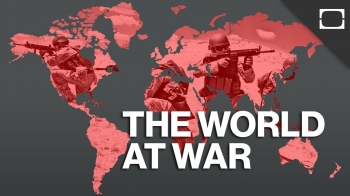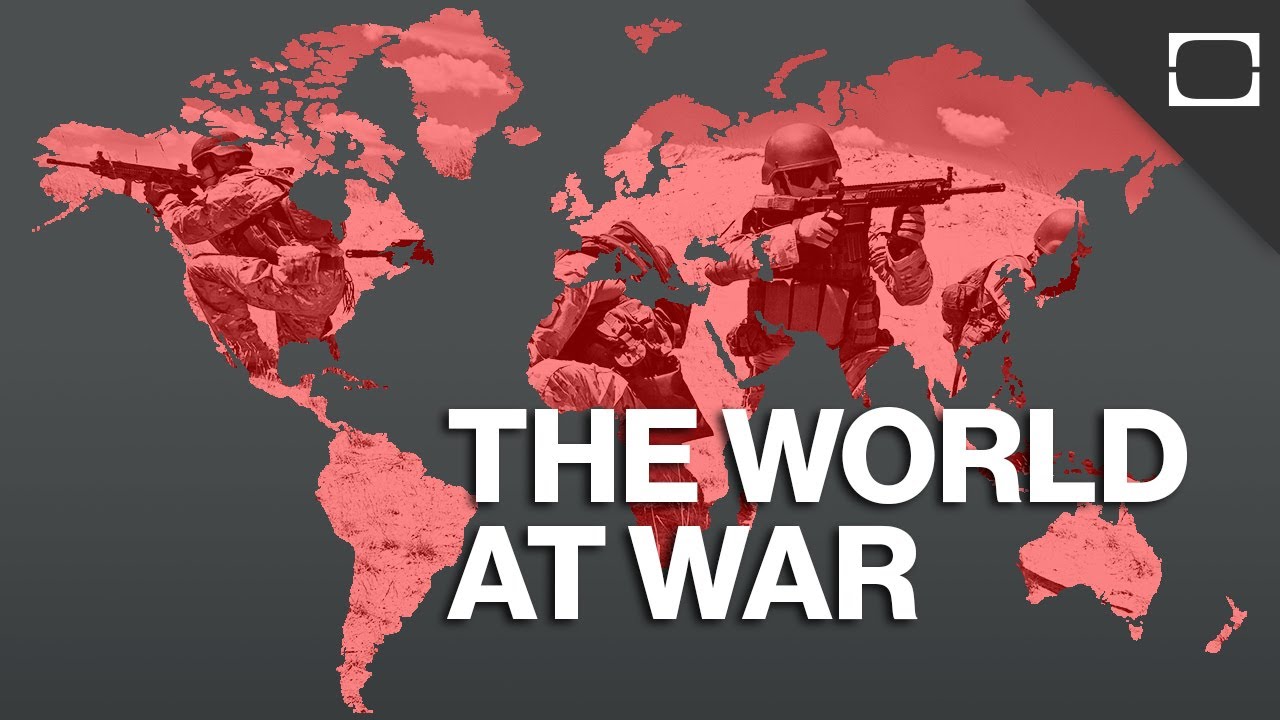
.jpg) Patrick Crasta
Patrick Crasta

Every country has a Defense department. In fact, they are offence departments. War-mongering is a strategy of most governments to divert the attention of the people from problems of their misgovernance.
The cold war between the United States of America and the Soviet Union made them prepare for a hot war by increasing their store of weapons, especially nuclear bombs and missiles with nuclear warheads. Their accumulation of these weapons reached to such an extent that each had nuclear armaments to destroy the world several time. Pity for them, there was only one world to destroy!
Fortunately, the cold war remained cold when one of the contestants, Soviet Union, imploded instead of exploding bombs. The country split into its original constituents, the various republics of the Union of Socialist Soviet Republics (USSR) and Russia inherited the nuclear weapons. With no prospect of a war, Russia found it difficult to maintain the weapons.
The USA, devoid of its enemy, did not know what to do with the nuclear weaponry. Yet it retained them with the excuse that it was the custodian of the security of the world, to maintain its supremacy.
Meanwhile, the production of conventional weapons in the capitalist countries thrived by selling them to the less developed countries. And these countries bought them to fight their hostile neighbors. Thus fomenting enmity became necessary for USA and the European nations for the prosperity of their arms trade.
Prosperity for them meant making billions of dollars. The Biblical tenet that it is as difficult for the rich to go to heaven as for a camel to go through the eye of a needle was dismissed as a scriptural exaggeration. But Pope Francis, the divine head of the Catholic Church, was more precise and businesslike in his recent commandments. He appealed to the arms manufacturers and dealers “to completely stop their activity because it foments violence and war, it contributes to the geographical games which costs millions of lives displaced and millions dead.”
Will the arms manufacturers and dealers listen to the Pope’s commandment? They are all Christians but think imitating Christ was impractical for them. They would rather contribute a million from their earnings of billions, to the church than listen to the Pope.
Coming to India, the paragon of peace and coexistence, it has now no friends among neighbors. Pakistan, the breakaway part from India, on the plea that religion was the basis of nationhood, is India’s perpetual enemy. Though its theory of basis has been disproved when its East wing severed to form Bangladesh, its hostility has been increasing out of a sense of revenge for its defeat in wars with India.
Pak authorities, elected ministers as well as military dictators, found their people’s camaraderie with Indians was harmful for them. They changed history books so as to inject communal venom to the new generations to perpetuate enmity with Indians. The defeat in the 1971 war and 92,000 Pak soldiers becoming prisoners in India, made Pak army burn with the fire of revenge. Added to this is Kashmir, a Muslim majority state, joining India; it became a perpetual thorn in Pakistan’s body politic. Not able to ‘liberate’ Kashmir by fighting India, Pakistan is instigating terrorism in the name of Islam and fomenting religious fanaticism among vulnerable Kashmiris to support them.
The Kashmiris have been unhappy with the prevalent regime. But would they have been better in the country of their religion, Pakistan? The Punjabis and Pathans would have caused elimination of their Kashmiriat. Their rosy cheeks would have faded with cross breeding. But who would think in perspective? Not those instigated by communalism. But for the amount of money spent on defense, India and Pakistan could have been much more prosperous. India has won all the wars with Pakistan. But winning wars too would cost enormous resources.
Now, coming to India’s other potential enemy China. India’s first Prime Minister Jawaharlal Nehru, a Gandhian innocent of strategic matters, followed the policy of India China Bhai-Bhai. He patronized China to get UN membership and later get into Security Council, where India is still not a member.
Nehru was going on a visit to Sri Lanka when he was informed some Chinese soldiers had intruded into Indian Territory. “Throw them out,” he ordered the Army and left on his errand. A full scale war started for which India, with its ideal of nonviolence, was not prepared. Indian soldiers were to fight with outmoded weapon in cotton clothes in mountainous sub zero temperature. Some dedicated ones who fought the Chinese were killed and most of the Indian army, commanded by inefficient generals, retreated so fast that the Chinese could not cope with the fleeing.
Fortunately the Chinese went back from most of the occupied territory. Meanwhile, USA dumped modern weapons and warm clothing in India to get the country’s favor. Also India was hastily acquiring modern weaponry ever since so that 1962 would not be repeated. But has India reached a stage it can fight China and win?
Ruling politicians evade that question. They have been claiming our defense is strong to defend our borders. But what is India-China border?
It is a line drawn on the map by a British surveyor Mac Mahon. China never accepted the line. But India, a British colony had to, and independent India continued to recognize the Mac Mahon line as the boundary, now known as the line of actual control (LAC).
There have been skirmishes when patrolling parties intruded to one another’s territory, but these were limited to fisticuffs. Never a single bullet has been fired by soldiers after the 1962 war.
Now what is the dispute with China? Our politicians in power, the Prime Minister and the Defense Minister assert that China has not occupied a single inch of our land. The patrol transgressing is left to the Army to settle and commanders from both sides hold parleys.
Meanwhile, animosity is built up for internal consumption to divert people’s attention from domestic woes. And Indian Army of some 50,000 soldiers is deployed in Ladakh and other mountainous cold places at immense cost. The great US General who became the President, Eisenhower, said: “There is no way in which a country can satisfy the craving for its absolute safety but it can easily bankrupt itself, morally and economically, in attempting to reach that illusory goal through arms alone. The military establishment, not productive in itself, necessarily must feed on the energy, productivity and brainpower of the country, and if it takes too much its total strength declines.”
This article is not to dwell on the military problems of India with Pakistan and China. It is a humanitarian effort for peace and harmony where patriotism takes a backseat.
It was presumed that World War II, with the defeat of Hitler, would bring world peace. But a cold war began for supremacy between Capitalist USA and communist USSR. America built the atom bomb just when the Second World War was going to end, and wanted to test the new weapon. It preferred to test it on Asians rather than on white Europeans. Japan which was about to surrender became the target. Two Japanese towns, Hiroshima and Nagasaki, were bombed. The effect was not military, of one army defeating the other, but annihilation of the population and the townships as a whole.
The potential of nuclear power for use as weapon inspired developed countries to go on an arms race. It started with the US and the USSR, later other members of the Security Council, the UK and France, had them. China too rejoined the permanent member league and its acquisition of the Bomb, was accepted.
Now the big powers thought enough is enough. They were apprehensive of other countries making the bomb resulting in local nuclear wars. Therefore, they decided that possessing nuclear weapons should be limited to them and made the United Nations to accept a pact known as Nuclear Nonproliferation Treaty (NPT). All countries agreed to the NPT except India, Pakistan, Israel and North Korea, who had acquired nuclear weapons. Though they are outside NPT, they have patronage of the nuclear powers except India and Pakistan.
Now, there are other forms of war as technology advances, posing threat to mankind. Recently China has launched a supersonic missile that can carry a nuclear warhead and go around the world and drop it where it wishes. US General John Hyten said: “It went around the world, dropped a hypersonic glide vehicle that impacted a target in China. China might one day launch a surprise nuclear attack on the United States.” Hypersonic weapons travel at more than five times the speed of sound making it difficult for radar to detect.
If China puts a nuclear weapon in space and could target it wherever it wishes, can India be far behind in putting one in space?
Then there is cyberwar that causes hardly any bloodshed but paralyze a country’s electronic services. It is to block and hack IT services of banking, transport services such as planes and trains and play havoc with the enemy county’s all activities.
More and more sophisticated kinds of war come with technological advancement which is a continuing process. It is up to mankind to choose how to destroy itself. And only humanity could save itself and the world from the danger, by establishing lasting peace. People should realize the games political rulers play and come out to defend the world, themselves and its ecology.
(The writer is a journalist and author of “Nuclear Myths” published by Gandhi Media Centre.)